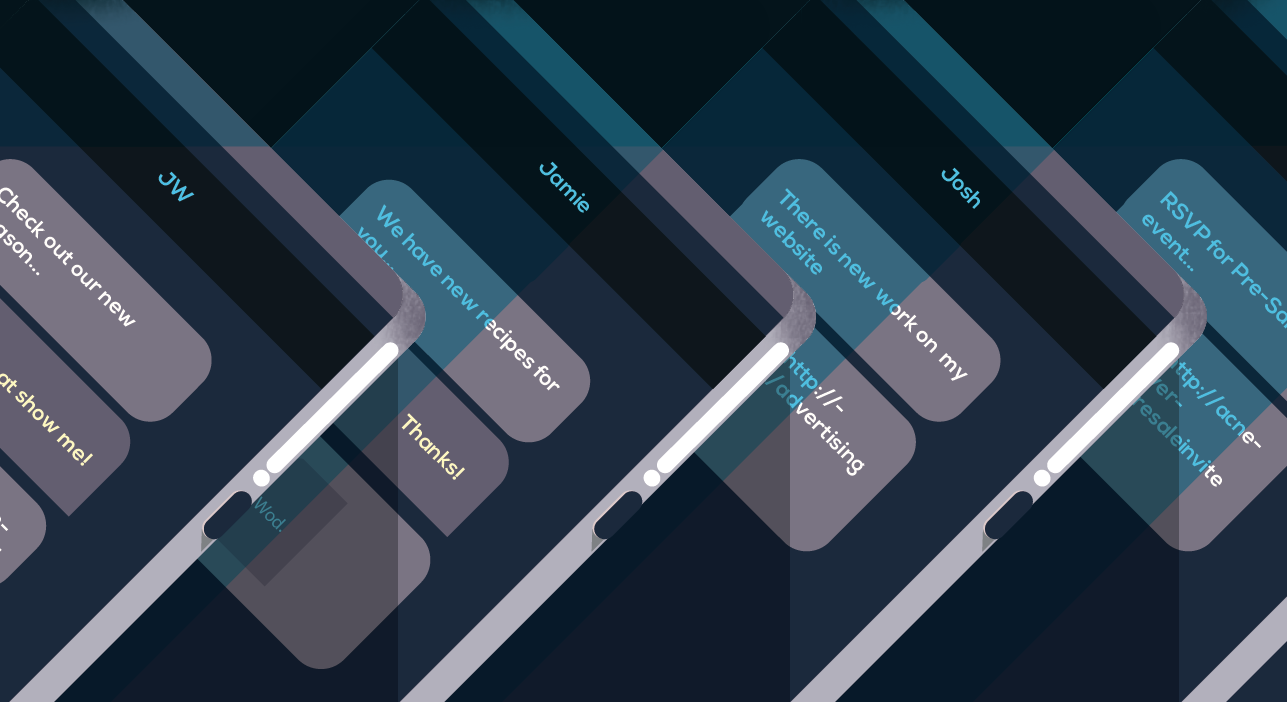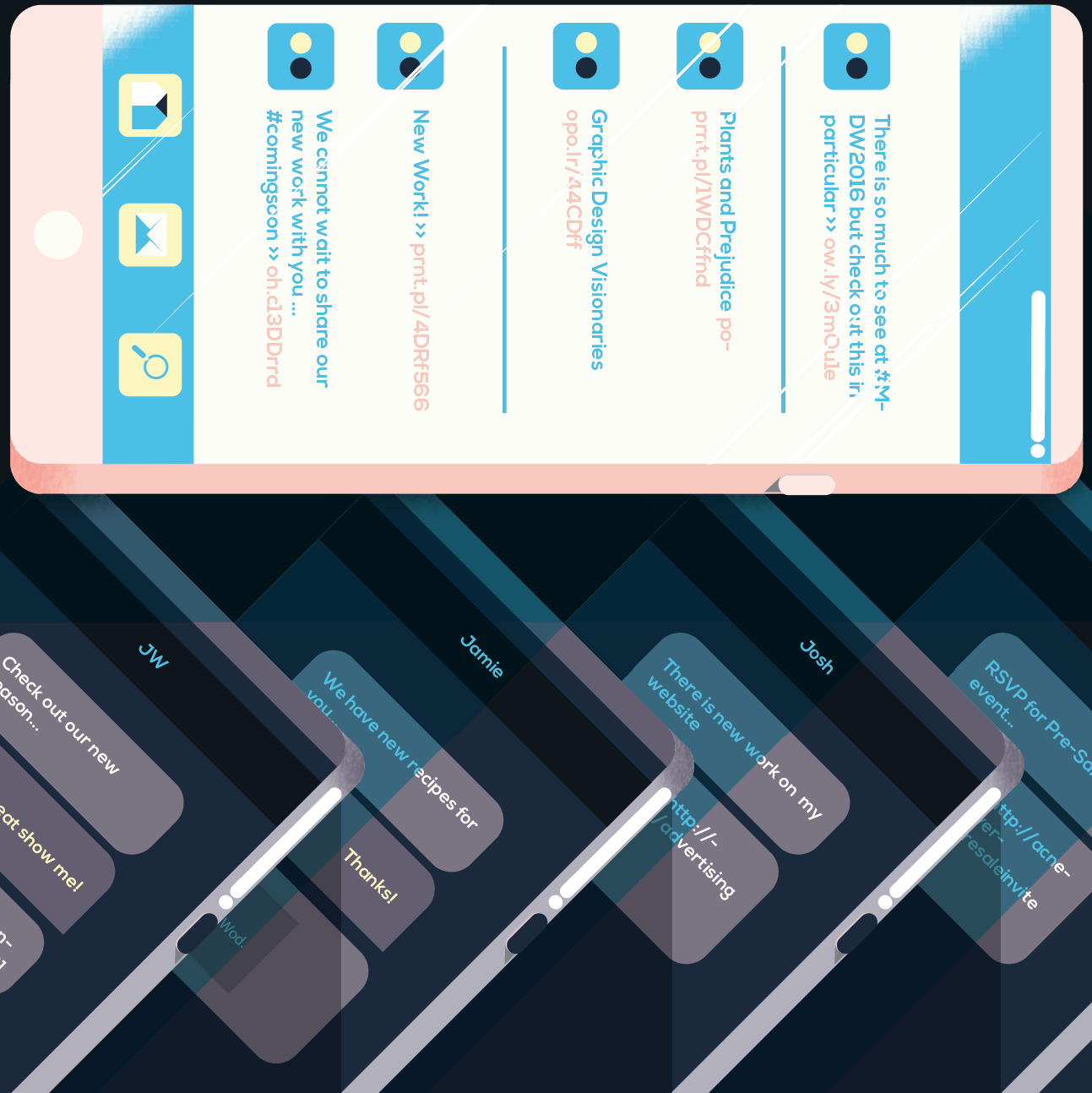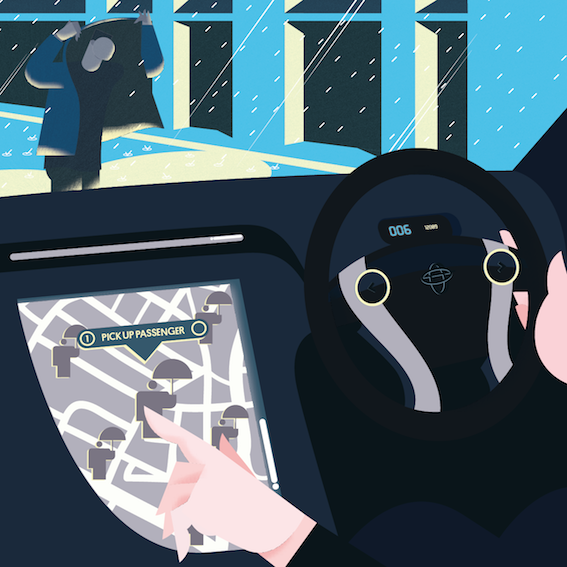Get the Message
A wealth of online activity has been going by ignored. This is Dark Social, the communication that marketers can’t measure.

Ever wanted to know much time we spend on Facebook daily? There’s a statistic for that - 20 minutes worldwide, and double that in the U.S.. Curious about how often the death of Cecil the Lion was googled last year? Your answer is 32 million. In the Internet of Things, almost everything we do is tracked, calculated and stored. It’s never been easier for a company to find out who came to their product via a retweet, who from Facebook and who off their own steam. If data were gold, we’d be in Eldorado.
Yet just beyond the reach of data crunching algorithms, a wealth of online activity has been going ignored. This is Dark Social, the communication that marketers can’t measure. Alex C. Madrigal from The Atlantic, who coined the phrase, likened it to the Internet’s equivalent of dark matter. Email your friend a link instead of posting it on their Facebook wall, or see something amusing you only want one friend to see? That’s dark social. “It’s what keeps the universe expanding,” he quips. And until recently, everyone’s been looking the other way.
Just beyond the reach of data\-crunching algorithms, a wealth of online activity has been going ignored
As it turns out, Madrigal found that 56.6% of The Atlantic’s views come through dark social, three times as much as Facebook. In a 2014 RadiumOne study, close to 70% of all online global referrals were found to come from dark social. In the UK, it was closer to 75%. Key apps in the dark social space include WhatsApp, which boasts 65m users and is the most popular messaging service in India, Mexico and Spain, where it has a 96% market share. Its success is no mystery: free to use and sleeker than clunky SMS interfaces, it makes sharing photos, videos and attachments far more seamless than in an email, especially on mobile phones.
Today, both small startups and big brands are discovering the potential that lies in dark social, and they’re coming up with increasingly innovative ways to use it to market, share and interact with their customers.
Brands go Dark
“While ‘dark’ sounds’ nefarious, the reality is that this is just where certain audiences like to stay engaged,” says David Cooperstein, founder of Figurr and former analyst at Forrester Research. Like many of dark social’s advocates, he believes these platforms offer consumers a more honest and authentic relationship with companies. “The benefit to a brand is that, if they do it right, they are part of the conversation, rather than an intruder.”
Although the term was coined in 2012, it’s only in the last year that brands have really come to embrace this previously unseen digital space. In March, Vogue became the first fashion magazine in the world to go dark. Simply text “fashion” and they’ll update you via Whatsapp with the latest news, catwalk photos and Oscar dresses. “No more scouring Twitter or relying on tabloids,” they promise.
Messaging app Kik, meanwhile, has become a go-to for brands looking to branch out into dark social. 42% of its 275m users are aged 18 to 24, making it the perfect platform for makeup brand Sephora. Kik is geared towards helping developers build chatbots to engage and interact with its young user base. Sephora’s bot imitates regular conversation and gets to know its customers through a short quiz, which it then uses to tailor which products, how-to videos and reviews that Sephora shares with them.
The benefit to a brand is that, if they do it right, they are part of the conversation, rather than an intruder

Perhaps the boldest and most ambitious move comes from adidas, who - in the same month as Vogue, rolled out their own WhatsApp campaign. In their “squads” - hyper local WhatsApp groups based in Berlin, London, Paris, Milan and Stockholm - community members share and discuss adidas content in return for exclusive news, event invites and access to the company’s roster of ambassadorial athletes and artists.
Careful to ensure that these communities of strangers share the same passions and interests, adidas pooled its members from existing followers on social media and from open invitations to more casual customers. They then analysed the data of each applicant before contacting them each via text message. In July, the squads will go global.
“Dark social is attractive for adidas because it’s the perfect collision of consumer behaviour and our ambition to become the most personal brand,” says Dan Bulteel, the company’s global social media director. “The insight and direct nature of the communication offers adidas a way to have an intimate dialogue, right in the pocket of our consumer, and through this one-to-one relationship we hope to understand our consumer better as well as create more meaningful brand experiences.”
Startups, in comparison, are building apps from the ground up that are specifically designed for dark social. Stefan’s Head requires no download, instead communicating via text message to inform you whenever one of their limited edition designer clothes go on sale. Before Stefan puts you on his ‘list’, he’ll ask for some verification to see if you’re worthy - such as your instagram handle - and then you’re free to chat to Stefan as you would a friend. It’s the brainchild of three New York entrepreneurs, who found that that their clients were “surprisingly into communicating via text and gravitated towards limited-run products.”
What sets Stefan’s Head apart from its competitors, according to co-founder Michael Kushner, is that “messaging to us is core to our brand and our purpose, so I think it comes off as authentic. I have a good feeling that Macy’s doesn’t have customers sending them selfies, asking if they should break up with their significant others, and having YouTube battles of obscure 80s French pop videos.”
Potential Problems
In the wake of the NSA leaks, consumers are increasingly concerned with how much personal data they share and who it is shared with. One of the major concerns with dark social is that it will simply make it easier to invade our privacy. Targeted ads based on social media data have generally backfired. In one University of Pennsylvania survey, 66% of adult Americans did not want adverts tailored to their interests. After researchers explained how ad-targeting works, the percentage increased.
Harry Wright from Ogilvy & Mather Group UK shares this concern. He believes that advertising in dark social might become reactive, thanks to the permissions we give when we agree to the T&Cs of these apps. “They will be able to trawl through every message, every call and every destination you visit,” he says, describing a world in which Burger King sends you a message when it reads that you’ve forgotten your lunch, or Uber contacts you when it sees that you’re walking down the street and it’s raining outside. “They will act like they have known you for years simply because they’ll have all the necessary information to hand.” Greg Swan from digital advertising agency space150 says that there is an “education gap” between consumers and new tech. Ultimately, however, he believes that will be “up to you to control your privacy,” so long as you have the tools to do so.

Cooperstein is more optimistic. “I think clutter is the things that will drive people away from brands. The Web has suffered an abundance of poor experiences which has led to ad blocker growth," he says. “But the Web was and is a more open environment. Since [dark social] platforms are tightly controlled, things like formats, frequency of message and brand permission should be better managed.”
Vogue’s WhatsApp messages, for example, aren’t any different from their tweets or Facebook posts. But on WhatsApp they’ll send no more than two alerts per day, compared to a dozen or so tweets per hour.
As more and more brands embrace dark social, Bulteel believes that the greatest danger is not over-infiltration but rather a lack of insight. “Until a brand understands the nature of dark social and how their consumer uses it then there is a severe disconnect between the two,” he says. “Brands must navigate the channel carefully and ensure what they deliver is what the consumer wants to see. Otherwise dark social could become a channel full of unsolicited communication which will turn the consumer off and reduce the potential.”
But how will brands know if all this hard work is paying off? Whereas typical social media platforms and Google Analytics provide the exact number of likes, shares and comments their content receives. Dark social is harder to measure, but the key is to look for how many page views came directly from a long URL, rather than coming through a public social media share. The catch is that bookmarked links appear on Google Analytics in the same way - so there is always an unknown margin of error.
However, for Kushner, trying to measure success through algorithms misses the point of dark social. “You cannot track a lot of information via SMS, [but] the best information comes from developing relationships with our customers through conversation. We end up knowing more about their taste and personality, like a friend would, which is important to us.”
The Future
With Facebook launching their Messenger chatbot platform earlier this month, whatever the future holds, it seems like dark social isn’t going anywhere. As Cooperstein says, “with nearly one billion users of WhatsApp alone, the move to less visible content arenas is going to remain a fundamental communication channel for people and brands." But no two platforms are alike, so a key challenge for the future will be to be constantly open to evolution and adaptation.
“Our strategy is to have a unique point of view for every social media channel where we have a community,” says Bulteel. “So if you follow us on multiple channels you are constantly surprised and not served the same message several times in different ways and formats.” Given the pace of app development, this can breed its own set of challenges. “The flavour of the year will keep changing,” says Cooperstein. “So marketers need to create a means to learn and test each of these apps.”
A key challenge for the future will be to be constantly open to evolution and adaptation
Moreover, there are few limits to who can benefit from dark social. During the West African ebola crisis that began in 2013, as well as last year’s earthquakes in Nepal, the BBC used apps Line and Yik Yak to share health and safety information to those vulnerable in the region. This March, BBC even began distributing documentaries via Viber.
But how else might dark social evolve? Bulteel believes video chats could become de rigueur, putting “a real face in a true personal relationship. But first of all,” he warns, “we need to test and learn and make sure it’s what the consumer wants.”
In the other direction, dark social could move offline. Brands might no longer need such large budgets for traditional marketing, as their customers will do it for them. Imagine members of messaging groups, like adidas’s squads, downloading signs for car windows or printing and distributing flyers to advocate the brand or company they believe in. Almond milk, for example, has a huge following in part because it successfully armed its fans with facts about its health benefits.
Regardless of what avenue is taken, dark social is developing into a fertile space for testing ideas and gaining insight. We might not know what’s next, but whatever the result, it’s clear there are some exciting things coming down the pipeline.


